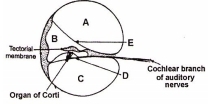Which of the following would not occur when we do physical exercises?
(1) Increased energy demand
(2) Increased oxygen supply and increased urine formation
(3) Increased in the rate of respiration, heart beat
(4) Increased blood flow via blood vessels
(1) Increased energy demand
(2) Increased oxygen supply and increased urine formation
(3) Increased in the rate of respiration, heart beat
(4) Increased blood flow via blood vessels
Macula lutea …a...
Fovea…b....
(1) Yellow spot, dark spot
(2) Yellow spot, pit
(3) Pit, yellow spot
(4) Dark spot, pit
Vitreous humor is
(1) Thin watery fluid
(2) Thick watery fluid
(3) Transparent gel
(4) Translucent gel
Mark the incorrectly matched pair regarding the structure with its location and functions:-
| 1. | Otolith organs | Located in the utriculus and sacculus, and is related to static equilibrium |
| 2. | Organ of Corti | Located on the basilar membrane and contains hair cells that act as auditory receptors |
| 3. | Visual cortex area | Located on the temporal lobe where sight impulses are analyzed and the retinal image is recognised. |
| 4. | Ear ossicles | Located in the middle ear cavity and increase the efficiency of transmission of sound waves to the inner ear. |
The contraction of which of the following muscles will cause constriction of pupil in the presence of bright light?
1. Radial iris muscles
2. Circular iris muscles
3. Suspensory ligaments
4. Superior rectus
The point of most distinct vision in case of human eye has a high number of cone cells. This point is known as
1. Blind spot
2. Macula lutea
3. Fovea centralis
4. Limbus
Find out the incorrectly matched pair with respect to structure and its function as mentioned below
1. Eustachian tube - Maintains air pressure in tympanic cavity
2. Cornea - Controls amount of light entering into eyeball, called the diaphragm of eye
3. Cristae in ampulla - Detect rotational motion
4. Semicircular canals - Help in maintaining dynamic equilibrium, not in hearing
Which of the following is not a correct statement with respect to the human eyes?
1. When all cones are stimulated equally, a sensation of white light is produced. The sensations of different colours are produced by various combination of these cones and their photopigments
2. Fovea of macula lutea has the greatest visual activity and resolution
3. Cones produces daylight (Photopic) vision and rods produces twilight (Scotopic) vision
4. Ciliary muscles contract when we focus our eyes on a far-placed object
Mark the part of brain where neural impulses transmitted by optic nerve are analysed and image formed on the retina is recognized based on earlier memory and experience
1. Optocoel
2. Optic lobe
3. Visual cortex area
4. Frontal lobe in occipital lobe

Go through the above sectional view of Cochlea. Identify A to E
| Options: | A | B | C | D | |
| 1. | Scala vestibule | Scala media | Scala tympani | Basilar membrane | Reissner’s membrane |
| 2. | Scala media | Scala vestibule | Scala tympani | Basilar membrane | Reissner’s membrane |
| 3. | Scala tympani | Scala media | Scala vestibule | Basilar membrane | Reissner’s membrane |
| 4. | Scala vestibule | Scala media | Scala tympani | Reissner’s membrane | Basilar membrane |






